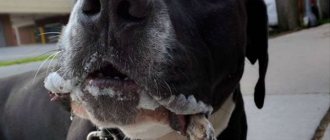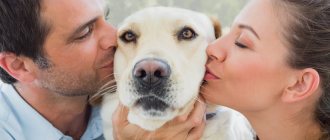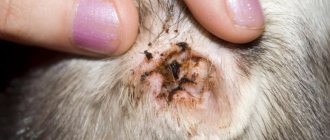How to recognize a dog's approaching old age?
Dogs show the same signs of aging as humans.
Gray hair appears in their fur, their eyes become dull, they eat less and less eagerly, they move more slowly, during walks they show little interest in the world around them, preferring to return home soon, they hardly or at all do not play and increasingly prefer to lie down in silence and away from others. dogs and from people. This condition can last from several months to a year if the dog is not suffering from the disease. He quietly fades away and becomes weaker and weaker until his time finally comes to leave his family. In older animals, the hair sheds and is not restored, and bald patches may form on the elbows, the area around the tail and on the stomach. Teeth may fall out, at least they are no longer sharp, but very worn down and darkened.
An old or chronically ill dog will breathe intermittently and wheeze, its hair will fall out and its nails will peel off, its nose will be mostly dry, its gait will be unsteady due to falling glucose levels, its urine will become dark in color, and its stool will often be loose for no apparent reason. The dog still reacts positively to affection, but does not actively ask for attention. More and more often he simply dozes in solitude. He may be irritated by loud noises, bright lights, and strangers. An aging animal, like an old person, needs peace, quiet, moderate temperature, dim lighting, a light diet and respect for personal space.
A sign of old age is a weakening of the sexual instinct. An elderly male does not care that a female dog is in heat nearby, he does not perform a courtship ritual and does not enter into competition with other males, and an old female dog who is in heat drives away male dogs and is not allowed to mount them on herself.
If an animal sleeps poorly, whines, moans, shows anxiety or aggression, it is most likely in pain. This is especially likely for dogs with tumor diseases, diseases of the kidneys, liver, digestive organs, and joint diseases. Pain syndrome is also observed in animals after injuries and surgical operations. In this case, you should contact your veterinarian to prescribe a pain reliever to alleviate the dog’s condition.
Many veterinary clinics offer hospital services with medical care for dying animals. But if the owner has even the slightest opportunity to leave the dog at home and give painkilling injections on his own, then it is better to give the dog the opportunity to die where he lived, next to his owner and his family. This is difficult for the owner, but more comfortable and honest from the dog’s point of view.
Signs of aging
In fact, owners whose dog dies at home among loving people from old age are truly lucky. They not only have the opportunity to make it easier for their pet to care for them, but also to say goodbye to it. After all, every day many pets die under the wheels of cars, from poisoning or simply from cruel treatment. Time flies very quickly, and yesterday's puppy becomes an old man. The arrival of old age can be judged by some significant signs:
- changes in coat. Over time, gray hairs begin to appear in the animal's fur, gray hairs are especially noticeable on the face. The structure of the coat also changes. It becomes brittle and crumbles. In many places (elbows, around the tail, on the stomach) bald patches appear that do not heal;
- change in behavior. The dog begins to give preference to a more calm and secluded pastime: it goes out for walks less and less often and reluctantly, avoids the company of other animals, stops playing, and has little interest in what is happening around it. She spends most of her time dozing lightly or sleeping. The pet begins to be irritated by bright lights and loud sounds, and the presence of a large number of people;
- general well-being. The pet's eyes lose their former shine, become dull, and cataracts or cataracts often appear. The teeth wear down and fall out, the claws peel off, the mucous membranes dry out, the gait loses confidence and elasticity, and shortness of breath appears. Appetite decreases, the dog eats rarely and in small portions. Urine becomes dark in color and acquires a more intense unpleasant odor;
- loss of interest in the opposite sex. The sexual instinct weakens: the male does not pay attention to the bitches during the period of heat, and old females do not allow gentlemen to approach them;
- exacerbation of chronic diseases or the appearance of age-related problems with internal organs. Moans, whining, aggression and apathy are frequent companions to tumors, kidney and liver diseases, gastrointestinal tract diseases, and joint problems.
At this stage, it is necessary, first of all, to allow the pet to lead a comfortable lifestyle: provide optimal temperature and lighting, a feeling of security and peace, unobtrusive attention, diet and care.
How can you tell if a dog is dying?
For any living creature, the process of dying occurs according to a scenario determined by nature. Dogs are no exception here. Here are the obvious signs that your pet will pass away in the next 24 hours:
Changes in breathing. The respiratory rate of an adult dog is 25-30 breaths per minute; in the last hours of life it is 10-12 breaths. The dog breathes shallowly and weakly. Gradually, his lungs stop filling, and they will relax for the last time after the pet dies.
Changes in heart rate. The pulse of a healthy adult dog is 80-120 beats per minute. In a dying dog it is approximately 50-60 beats. In the last minutes of life it is almost impossible to feel it, you can only hear it through a stethoscope or phonendoscope.
Complete refusal of food and water. The animal does not want to eat or drink, and has zero interest in treats. He no longer needs to support his body. Dehydration causes the nose and mucous membranes of the mouth to become dry and may peel and crack. It is useless to force water and feed; the dog either cannot swallow, or what he swallows causes an attack of vomiting. Droppers with nutrient solutions will also not have a resuscitating effect.
Vomiting, involuntary urination and involuntary stool, usually liquid. This happens because the dog does not control his body, all his muscles relax. People say that the animal has “purified itself.” Urine leaks almost constantly, and feces and vomit consist of mucus, sometimes mixed with blood. You shouldn’t scold the dog for this, he still won’t be able to restrain these processes, because he doesn’t feel the urge. It should be placed on absorbent diapers and periodically wiped with damp wipes.
Inability to stand on one's feet or inability to maintain a standing position. Owners often massage and place the pet on its paws, trying to restore sensitivity to its limbs. But all this is to no avail: the brain loses neural connections with muscles and ligaments and slowly dies.
Convulsive twitching and decreased sensitivity. In the last hours, even seriously ill dogs feel almost no pain. But there is no need to give up painkillers, since many diseases are accompanied by excessively severe pain syndromes, for example, cancer.
Loss or confusion of consciousness. The dog either does not react to stimuli at all, or reacts weakly and indistinctly. He no longer sees, does not hear, and probably does not smell, but all owners note that even a pet on the verge senses their presence and even tries to wag its tail.
Amyotrophy. It is observed in very old or long-term and seriously ill animals. The dog can’t hold his head up, his paws are moving apart, his mouth is half-open, and under the skin, instead of muscle knots, it feels like dense jelly.
Dry skin and loss of elasticity. If you pinch the skin, the fold will not straighten out, and the color of the mucous membrane will not return to normal pink. It is caused by dehydration, loss of nerve supply, and loss of brain control over the body.
Why do dogs leave home?
It is difficult to say whether dogs sense their death, but it often happens that an old or sick dog leaves home and disappears, it depends on its socialization. The owners find her dead and understand that the dog left on purpose - in anticipation of the end.
There are several versions as to why dogs leave home before they die. Some even believe that the animal feels the pain and bitterness of its owners and, by leaving, tries to alleviate their condition. But this is not true. To do this, you need to have human consciousness. It is the person who grieves for their deceased loved ones, who is afraid of death and thinks about it. The animal does not feel all this, since life and death are equally natural for him. Morality, ethics, aesthetics, religion, civilization - all this is alien to animals.
Biologists believe that a dog leaving home before death is caused by the same reasons as an old or sick wolf leaving its den. The dog’s consciousness becomes clouded and the skills acquired during life with humans are forgotten, ancient instincts come into play, to which all canines obey:
- You cannot burden a flock with a creature that cannot run quickly and hunt successfully,
- You cannot attract other predators to the flock with easy prey in the form of a weak individual,
- If you don’t hide, there is a risk of being torn to pieces by a large predator and dying painfully,
- If you die in a flock, the young animals will suffer from the products of decomposition.
Presumably, due to these motives, domestic dogs overcome their weakness and leave the house. However, dogs that have retained consciousness and attachment to humans overstep instinct and are left to die in the house in the arms of their owners.
Features of behavior
Of course, there are certain, empirically verified signs of impending death in dogs. When the following symptoms become more obvious, you need to be prepared for the possibility that your pet may die within the next 24 hours. First of all, pay attention to the breathing frequency: it becomes half as fast as usual, and the breaths themselves are shallow and weak. This indicates that the lungs gradually stop filling. The pulse weakens and slows down significantly; without a phonendoscope, it can no longer be heard or palpated. Its frequency is no more than 60 beats per minute.
The dog stops not only eating, but also drinking. The fading body no longer needs support; there is also no strength left to eat food. Due to dehydration, the mucous membranes gradually dry out and crack. It is not recommended to forcefully introduce food; even nutrient droppers will not help. And introducing regular food will only cause vomiting and stress in the animal. Reflexes become uncontrollable: the dog involuntarily vomits and defecates, the muscles are relaxed, the body is uncontrollable. Urine output may be very frequent, and vomit and stool consist primarily of bile, mucus, and blood.
The pet cannot move, and simply standing up is a problem for him. Neural connections between the brain and nerve endings in the muscles weaken and die. The muscles atrophy, the skin becomes dry and inelastic. Sensitivity becomes dull, and spasms run through the body more and more often. At this stage, the animal no longer feels pain, but if the pet is sick, then administer painkillers after all.
How to help a dying dog
To make it easier for your pet to pass away, you should observe how the dog behaves before death. A dog's behavior before death always changes, and an attentive, loving owner cannot fail to notice this. If a dog dies easily, then he needs nothing but peace and quiet, and sometimes the presence of his owner. Many dogs lick their owners' hands and wag their tails even in their last moments of life.
If dying is associated with the dog’s physical suffering, then the owner’s duty is to alleviate his condition and decide on euthanasia or consider all options for a worthy farewell to his final journey. This is not murder, as many people think, but the last help to someone who has been around for many years and who helped cope with everyday difficulties as best he could.
Euthanasia is necessary for animals dying from cancer, due to multiple injuries, severe head trauma, multiple bleeding, or an incurable infectious disease. Only a veterinarian can perform this.
No matter how much we love and are attached to our smaller brothers, unfortunately, sooner or later, like all living beings, animals go to another world. Death, even in relation to dogs, is a truly sad reality that all, without exception, breeders of these beautiful creatures devoted to us will have to face. But so that the death of a pet does not become a sudden blow, we will consider the signs of approaching extinction, by which you can understand that the dog is dying. Perhaps this knowledge will at least help you mentally prepare for the calm departure of your beloved dog.
Abstractness of death
However, Koren insists that the ability to understand something as abstract as death may be beyond the capabilities of dogs. It is limited to humans and perhaps a small number of other highly cognitively advanced animals such as elephants and some primates. Dogs are actually very social animals and therefore understand that they have lost a person who played an important role in their lives. But they are unlikely to realize that their owner is gone forever and will not be able to return to them.
But how then should we perceive the behavior of Hachiko, Hawk and the other numerous dogs who reportedly waited at the graves of their owners for many years? Koren says they were most likely anticipating a return rather than mourning the death. The dog probably wouldn't have been particularly surprised if its owner had gotten up and walked out of the coffin.
People online praise kids for handling pandemic
Here's the twist: the Bond girl is alive! Tanya Roberts is in hospital
Where they throw ice cream, where they pour water on them: New Year's traditions of different nations
What do dogs die from?
The appearance of a pet in the house is not only a joyful, but a responsible event. From the first days, the pet needs proper systematic care, attention, care and love.
Important! The duration and quality of life of our little brothers largely depends on the actions and attitude of the owner and family members towards the animal.
We need to understand that our pets live much shorter lives than people. The average lifespan of a dog is 10-13 years. There are cases where dogs lived up to 17-18 years. But these indicators are individual for each specific animal and the life of a pet can end at any moment.
At the same time, representatives of large, giant, medium breeds can live only 9-11 years, small dogs live 12-14 years. Life expectancy depends not only on the breed, but also on many other reasons (care, health status).
Dogs die:
- from old age;
- viral-bacterial, infectious diseases;
- invasive diseases;
- incurable infections;
- cancer;
- autoimmune, advanced chronic pathologies;
- congenital, genetic abnormalities.
Often the cause of death for dogs is severe injuries, injuries incompatible with life. Puppies, young dogs, unvaccinated pets can die from diseases (viral, bacterial) if treatment is not started in time. However, most diseases of infectious etiology develop at lightning speed, and the dog should be treated immediately after the first symptoms appear. Some diseases can only be cured at an early stage of their development.
Dogs die from poisoning from poisons, potent toxins, chemicals, and medications. Therefore, to prevent this from happening, keep medicines and medicines at home in places inaccessible to dogs, and on walks, make sure that the dog does not pick up crap from the ground.
Signs after the death of a dog
When a pet dies, many people sincerely believe that this promises some kind of change in life. According to signs, actions after the death of a dog can also be fateful.
If a dog is buried near the house, this will lead to failures in the family and negative changes. The spirit of a deceased dog can yearn for its owners and even “carry” them along with it.
Buying a new puppy after the death of your previous pet should be taken no less seriously. According to popular belief, you should get a four-legged friend no sooner than after 2 months, otherwise the puppy may unexpectedly die or begin to get seriously ill. This oddity is explained by the fact that the deceased dog is “jealous” of the owner of the new family member and does not want anyone to take his place.
In ancient times, they tried to burn the corpse of a dog so that the animal would not resurrect and harm the surviving pets. Today, hardly anyone believes in such things; the ancestors were not without wisdom when they set an animal on fire far from home, and this is worth following, even if you do not believe in omens.
In the end, infections and incurable diseases have not been abolished, so it is worth taking care of sanitary standards, especially if the dog died from unknown causes or a disease that can spread.
Signs of an old dog
Aging in dogs occurs in much the same way as in humans. The condition of the fur deteriorates, gray hair appears, and the look becomes dull. Elderly, old dogs become less active, move more slowly and more carefully, often refuse active games and outdoor entertainment, and during walks they are practically not interested in the world around them, preferring to lie in silence away from people and animals.
This condition can last from several weeks, months or up to a year, but provided that the animal does not suffer from any pathologies. The dog is quietly fading away, weakening, so be prepared that one day your beloved pet will leave this world.
Important! In addition, you need to understand that chronic, systemic pathologies can worsen in elderly pets. If the dog sleeps poorly, sleeps restlessly, shows restlessness, constantly whines, moans, refuses to eat, or other symptoms are noticeable, this most likely means that the dog is experiencing discomfort and suffering from pain. In this case, the dog can literally fade away before our eyes, especially with oncology.
The main signs of old age in dogs:
- decreased activity, slower movement;
- drowsiness, lethargy, depression;
- weak reaction to external stimuli;
- heart rhythm disturbance;
- decreased visual acuity;
- deterioration of coat condition;
- changes in behavior;
- violation of movement coordination;
- sudden weight loss;
- decreased appetite;
- change in taste preferences;
- frequent urination, defecation, unstable stool.
In older, older dogs, after 9-10 years of age, the shedding time increases, while in many, the fur does not recover several months before death. Bald spots and hairless areas appear on the body, especially in the croup area, around the tail, on the limbs, and sternum. The coat is matte, faded, and falls out in clumps.
In old animals, the teeth (canines, incisors) acquire a yellow, yellow-brown tint, are heavily worn down and may fall out. Dogs have a hard time chewing bones and hard food.
Another sign of aging dogs is a decrease in sex drive. Even hyperactive, loving males, as they age, cease to be interested in individuals of the opposite sex, and after 10-11 years they absolutely do not react to the advances of females. The same applies to females during the period of sexual hunting. Even during the rut, the bitch will do her best to drive away annoying suitors, not allowing them to mount her.
Other signs and manifestations of an aging dog
A sure sign of approaching old age in animals is a decrease in appetite. A dog that had an excellent appetite and constantly begged for treats from its owner may periodically refuse food or constantly be undernourished from its usual portion size.
Even if the owner gives his favorite treat, the dog may refuse it, but as a sign of gratitude he will lick the owner’s tidbit or hand. This condition is explained by a decrease in the body’s energy needs, as well as a slowdown in metabolism. Do not force your pet to eat or try to force feed the animal.
After eating, older dogs may develop metabolism, bloating, belching, and hiccups. It is not uncommon for dogs to vomit some of the food they eat after eating. Do not forget that due to age-related changes, the functioning of internal organs and systems is disrupted.
In the gastrointestinal tract, with age, the number of enzymes that take part in the digestion and absorption of food decreases, and the number of beneficial intestinal bacteria decreases. Therefore, after eight years, veterinarians recommend nutritional adjustments.
The diet should consist of easily digestible nutritious food. If your dog is kept on ready-made industrial complete food, purchase products marked “For old, elderly” premium, super-premium animals.
In older dogs, there is a frequent urge to urinate and uncontrolled emptying of the bladder. At the same time, even if the dog asks to go for a walk, the pet can relieve itself at home or in the entrance, and it is strictly forbidden to scold the dog for this.
In aging dogs, unstable bowel movements (constipation, diarrhea) are common. The process of defecation can cause discomfort and be accompanied by pain.
Pay attention to your gait. Older, older dogs move more slowly and carefully. In some pets, you may notice an unsteady gait, frequent involuntary muscle spasms, and convulsions.
Sometimes there is a weakening of tongue control. In this case, the dog’s mouth is constantly open, the lower jaw hangs, and saliva flows.
In dogs, chronic diseases, pathologies, and illnesses become more acute. Representatives of large breeds are diagnosed with joint diseases, muscle weakness, and ophthalmological and endocrine diseases are identified.
Recently, cases of oncology have become more frequent and, as a rule, cancer is observed in dogs of older age groups. Unfortunately, owners are not always able to recognize cancer in the initial stages of its development. Therefore, dogs are brought to the clinic only when the tumor has metastasized and in this case it is impossible to save the pet. The veterinarian can only prescribe maintenance therapy, which is aimed at improving the pet’s life and reducing pain spasms.
Caring for an elderly animal
The old age of a beloved animal can approach unnoticed by the owner himself. However, this is inevitable. It will be good if a person can devote more time to his old friend. It is recommended to spend more time outdoors, remember to eat properly and visit a doctor regularly.
The latter is especially important. After all, as has been said more than once, a dog’s old age is accompanied by a number of concomitant diseases that can be identified at the initial stages.
An important question that worries the owners is why the dog died in one day? There are quite a lot of options. It could be:
- rabies;
- the animal ate poison or a product laced with dangerous drugs, for example, rat poison;
- The strong bite caused damage to internal organs.
Some illnesses, such as cancer or breast inflammation, can take a very long time to develop and are almost unnoticeable. The pet’s condition simply deteriorates at one point and it begins to rapidly die. Lymphoma is also dangerous and almost invisible. What does this mean? And you need to find out about terrible diagnoses in advance. This is the only way to help your pet live longer and not experience severe pain.
As for nutrition, it is recommended not to skimp on food or prepared food. It goes without saying that an animal must eat high-quality food throughout its life. In old age, special attention should be paid to this. In particular, if the dog eats ready-made food, then it should be premium and super-premium.
Caring for an old dog
How to understand that a dog is about to die
Unfortunately, the death of pets can occur suddenly, as already noted, due to illness, severe injuries, severe poisoning, or intoxication.
But if the dog is healthy, you can understand that the pet will soon pass into another world and this sad event will happen in the next 24 hours, not only by the changed habits and behavior, but also by the following signs:
- Shallow intermittent breathing. The normal breathing rate of an adult dog is 25=35 breaths per minute. Before death, this figure is 10-12 breaths/min. Gradually, the lungs stop filling, breathing becomes barely perceptible, and when the dog dies, it completely subsides.
- Change in heart rate. The pulse of a dying dog is thread-like and is approximately 55-65 beats/min. In the last hours before the death of the animal, it is practically not palpable.
- Involuntary defecation (diarrhea), urination, vomiting. Very often, before death, animals involuntarily defecate. This is explained by the fact that animals are no longer able to control their body; their muscles are completely relaxed. Vomit and feces contain mucus, foam, particles of undigested food, and bloody substances. The urine is dark in color, and the feces emit an unpleasant, specific odor. The excrement may contain foam, blood, or foreign inclusions. After death, the dog will pee and defecate for the last time due to loss of muscle control.
- Inability to stand up. A few days before death, the dog gets up little and practically does not leave his bedding or house. Disorientation in space and loss of coordination of movements are possible. Often, a pet, trying to get up, falls on its side or immediately squats. In this situation, neither massage, nor rubbing, nor medications will help. The brain gradually dies, loses neural connection with muscle structures and ligaments.
- Complete atrophy of muscle structures. A similar condition is observed in very old dogs, as well as in animals that, due to illness or problems in the musculoskeletal system, have not moved much in recent months. The dog's legs move apart, it is difficult for the dog to hold his head up, and the dog does not get up from the bedding. When palpated, the muscles resemble jelly to the touch.
- Dry skin. Before death, the epidermis loses its elasticity. The skin becomes rough, dry, and does not return to its usual place if it is pulled back. This is explained by dehydration and changes in the structure of collagen fibers. The epidermis may look pale and bluish.
- Loss, clouding of consciousness.
A few days before death, dogs' tactile sensitivity decreases. The dog feels virtually no pain. Moreover, if the animal is sick, to reduce pain, especially with oncology, you need to continue to inject or give the dog analgesics prescribed by the veterinarian.
You may notice involuntary muscle spasms and cramps. Before death, the pet reacts very weakly or absolutely not to external stimuli, regardless of the intensity of their impact. At the same time, it is possible that the dog hears, understands, feels you.
In some cases, if the dog has been suffering from a chronic disease for a long time, supportive therapy, treatment does not produce any results, the animal is in severe pain, the veterinarian will suggest elective euthanasia. This is an easy, quick and painless death. Euthanasia relieves a pet from physical suffering, minimizes the pain and fear of loss of consciousness that animals experience before death.
Euthanasia is carried out by veterinarians in cases of cancer, the presence of multiple serious injuries incompatible with life (head injuries), as well as in the case of diagnosing incurable infections (rabies, Aujeszky, tuberculosis).
Advice! Whether or not to euthanize a dog is a decision only for the owners. But in many situations this is a more humane method in relation to your beloved dog. It’s really unbearable to watch your pet suffer and you can’t do anything to help him.
To ease your pet's suffering and pain, constantly monitor its behavior. Surround your dog with care and proper care. If the animal dies easily, provide it with peace and quiet. Try not to leave your dog's side. This way the dog will feel more comfortable and calm in the last moments of his life.
How might a dog react to death?
There's no doubt that dogs react to the death of their owners in a variety of ways, from the heartbreaking to the bizarre. One of the most touching examples is Hawk. This is the black Labrador that lay next to the coffin of his owner, a naval officer, during his funeral in 2011. Let’s not forget about Hachiko, who became a national sensation in Japan in the 1930s. He accompanied his master to the railway station every day and returned there to greet the man when he arrived from work. But one day, Hachiko's owner was unable to return, yet the dog continued to appear at the station every day for the rest of his life.
Burns from pyrotechnics: the doctor spoke about the most common injuries in the New Year
Ready to move in: what a tiny house looks like inside
Scientists discover deep-sea coral cities at the bottom of the Atlantic
However, despite these and many other examples of behavior, it is very difficult to tell what dogs actually think and feel about the death of their owners and how intense their grief is.
Why do dogs run away from home before they die?
It is believed that dogs and cats sense their approaching death. If the dog is strongly attached and devoted to its owner and family members, in the last days of its life the dog will constantly be near its owner, literally following on its heels. Pay attention to your beloved pet, try to make his last days and hours as pleasant and comfortable as possible. Surround your dog with love, affection, warmth.
It happens that dogs, sensing approaching death, run away from home. There are several versions explaining this behavior of a pet. Some experts agree that dogs run away from home because they sense the anxious state of their owners. But by and large this is not true. Although dogs can recognize our emotional state, in order to do this, you need to have human consciousness. Moreover, for animals, life and death are equally natural.
Most biologists agree that a dog's escape from home before its death is explained by the same reasons as the departure of a sick old wolf from the pack. In recent days, dogs have become clouded in their consciousness, the skills instilled in the process of communicating with humans are forgotten, but at the same time their natural instincts are activated. It is because of this that dogs, overcoming weakness, try to get as far away from home as possible.
Important! But if the dog has retained consciousness and is very strongly attached to its owner, it will spend its last days with members of its pack and will be left to die in the house or in the arms of its owner. Don't regret your free time, spend it with your beloved dog, stay with the animal as much as possible.
After your dog passes away, you will long remember the pleasant moments from communicating with your dog. Perhaps a new pet will help reduce the pain of losing a devoted, loyal friend. A restless, funny puppy will again fill the house with joy, positivity and help avoid depression caused by the death of a beloved dog. Decide on the breed and give the dog a new name.
Why know that a dog is dying? It's sad, it hurts to even think about it. However, knowing that you will soon face grief will make it easier to cope with, and you will have time to prepare younger family members. You will be able to be with your pet in its last days and show how much you love it.
Moreover, only you can decide whether the dog will experience pain before death or whether you will take a strong-willed but correct action - let it go a little earlier, but in complete calm.
Euthanasia or death from disease is a difficult choice
Inexperienced owners often torture their pets, making excuses that euthanasia is murder. We will not refute the truth that euthanasia or euthanasia leads to the death of a dog. However, every time you see a pet in pain, watch a disease kill it, ask yourself: am I acting humanely?
Naturally, you want to stay with your pet for as long as possible, to know that you did everything and were there until the end. Try to think about the pet, about its well-being, about its comfort. Unfortunately, in this matter you have to show all the composure and rationality that you are capable of at that moment.
We do not call for resorting to euthanasia if the dog has at least the slightest chance of recovery and a full life.
Our pets live much shorter than us. Dying of old age, they leave their owners the pain of loss and a lot of wonderful memories of games and walks, pranks and pranks, happy and sad days spent together. Sometimes illness takes them away, they are poisoned by poisons or find themselves in emergency situations, but in such cases, confident and competent actions can prolong the life of the pet and save it. Any owner should know how dogs behave before death in order to have time to seek veterinary help, facilitate his death, or simply be close to his friend during the last hour.
How and why dogs die
You can notice signs of a dog's imminent departure within a week, in a few hours, it all depends on the reason. Violations will affect all vital systems. It is important to understand whether the dog is in pain.
So, the causes of early death can be divided into three large groups:
- Old age is a natural process of degradation of all vital systems, including blood vessels, brain neurons, cell conductivity, etc.
- Death from illness can occur at any age. It is in this case that owners often have to make the decision to euthanize.
- Sudden death from an accident, poisoning, shock, trauma and does not depend on systemic diseases or age.
The third point cannot be predicted, but everything can be done to protect the dog from dangerous situations and actions. You need to train your pet, socialize it, and help it get rid of phobias. Remember:
- A happy dog is a controlled dog.
- The safety of your pet is you, your actions, your actions, your forethought. It is absurd to blame someone for the death of a pet if you yourself let it off its leash near the road and it got hit by a car.
The situation is similar with all other accidents, if such a situation occurs there is only one reason - lack of education, attention, in a word - hindsight.
It is important to always follow basic safety precautions. If you are unsure of your pet's control, do not let it off the leash; if you are unsure that your pet will not take poison from the ground, walk it with a muzzle.
Main features
The following signs will let you know that your dog is about to die. Depending on the situation, these signs will either provide a last chance for salvation, or time to prepare and say goodbye.
Activity is one of the most striking signs of fading vitality, this is a decrease in activity. Out of habit, the dog will ask to go outside, try to endure the toilet, follow the owner’s commands, and behave as usual. However, an observant owner will notice that games and walking do not bring the animal as much pleasure as before. After a walk, the dog will lie down in its place and sleep for a long time, and will not enjoy prolonged communication.
Reflexes – against the background of decreased activity, lethargy and impaired reflexes occur. At first, these violations will not be obvious, but you will notice that the pet tries not to run fast, avoids sudden maneuvers, and often lies down during walks. Even dogs that were cocky in their youth begin to give in to young animals and aggressive relatives. At this moment, it is important to support your pet and try to ensure its maximum safety and self-confidence. If you notice that your dog feels uncomfortable on a walk, consider moving the walk to a more secluded place.
Metabolic slowdown - many dog lovers say that the dog’s appetite worsens in anticipation of death, but this is not always the case. In the process of natural cell degradation and metabolic processes, the following trends can be observed:
- The dog eats well, but does not gain weight.
- The pet independently reduces the daily food intake, but drinks well.
- Despite normal fluid intake, the dog develops dehydration.
- The dog develops vitamin deficiency or a clear deficiency of nutrients.
Weight loss with a normal diet can indicate not only a metabolic disorder, but also a number of diseases:
- With a helminthic infestation, the dog will lose weight, but its appetite will only improve at first. If your pet is elderly and you suspect a helminthic infestation, you should consult your veterinarian about adequate preventive measures. Not all drugs designed to remove worms are designed to take into account the slow metabolism of older animals.
- Weight loss while eating normally may indicate systemic diseases, such as diabetes or other abnormalities in the body. Carefully monitor your pet's condition, since in old age the risk of developing diseases to which the dog is prone increases.
- Skin and coat - against the background of impaired metabolism, a dog may consume the usual amount of water and food, but suffer from a deficiency of microelements or dehydration. One of the most obvious signs of dehydration is poor skin and coat condition. The wool becomes disheveled, loses its natural shine, becomes severely deformed, and breaks. If you look closely at the skin, you may notice a large number of scales or even cracks. However, do not rush to conclusions and take your dog to the vet. This may indicate seborrhea, which most older but still physically strong dogs are prone to.
- Breathing – disruption of the respiratory system – is a clear sign that your pet is about to leave. When metabolic processes slow down critically, the dog falls into a lethargic state. You may notice a slowing in your breathing rate. Depending on the size of the dog, the normal breathing rate varies from 22 to 30 breaths per minute. When breathing slows down, the dog breathes slowly, deeply, often with an open mouth. The breathing rate usually decreases to 10–11 breaths per minute. Just before death, the dog continues to make breathing movements, but in fact it does not inhale or exhale air, since the lungs no longer expand.
- Heart Rate – After slowing down your breathing, you may notice a clear decrease in your heart rate. A healthy dog has a strong pulse with a frequency of 100-130 beats per minute. In a dog whose metabolism is slow, the heart rate drops to 50-80 beats per minute. When the pulse decreases, a natural drop in blood pressure occurs, which is accompanied by severe weakness and apathy. Usually the dog tries to hide in a dark, secluded place, hardly moves, and when trying to move from place to place, the pet sways greatly. At this stage, only the dog’s comfort depends on you; if the pet dies of old age, you can assume that this condition is irreversible. However, be prepared for the fact that the dog may remain in a state of lethargy for a day or even more. There is no need to force your pet to eat, drink, or get up.
- Digestive system - a few days, and maybe hours, before death, the dog will completely refuse food. In this case, the pet may involuntarily empty its intestines and bladder. Even if the dog does not eat anything, feces will remain in the intestines, since the peristalsis of the intestinal walls is greatly reduced. Offer water to your pet, but do not force your dog to drink. Be prepared for the fact that in the last days and hours, the pet will go to the toilet under itself. If the dog gets up and asks to go outside (and this often happens), take it out for a walk in your arms and immediately bring it home. Immediately after death, the dog will have an involuntary and complete emptying of the intestines and bladder. This happens because the muscles completely relax after the death throes.
- Mucous membranes - against the background of dehydration, metabolic disorders, and nutritional deficiency, the dog may develop oxygen starvation of cells. At first, you may not notice anything other than a change in the color of the mucous membranes of the eyelids and gums. Typically, the gums become gray, whitish, or almost transparent. Try to measure your pet's temperature; if it is low, provide the dog with warmth. When the temperature naturally drops, the dog experiences chills, and when the animal is cold, it cannot relax - this is a reflex.
About the death agony
Many owners panic when their pet is in its death throes. Fear is caused not even by the loss of a dog, but by the state in which it is interrupted before death. It is important to learn one thing, you cannot change anything, but it depends on you how your pet will feel in the last moments of its life. Keep calm with all your might, don’t cry, hug the animal, calm it down, try not to let your voice tremble.
Yes, these recommendations look cold, they are almost impossible to follow when the pet licks his hands and says goodbye. You may not believe it, but dogs have a presentiment of death, they are afraid of it just like people.
Learn one more truth, your pet devoted his whole life to serving you, he was ready to do anything to make you happy. Try to be happy in the last moments of his life, so that when he leaves, your pet knows that he coped with his task perfectly.
Let's take a break from philosophy, what is the death agony? As mentioned above, a few hours before death the dog falls into lethargy. This state can be described in different ways: indifference, complete calm, tranquility, and so on. From a scientific point of view, lethargy is a partial cessation of the functioning of brain neurons. Being in lethargy, the dog practically does not feel pain, loses its sense of smell and hearing. The last thing a dog loses is its vision and sense of touch, which is why it is so important to be close and constantly in contact with it.
When it comes to death from old age, we can say that death is painless. The pet may feel sick. Nausea in this case is natural and should not be stopped. Try to maintain eye contact with your dog until his pupils dilate and no longer respond to light.
Lack of pupil accommodation indicates complete lethargy or coma. After loss of vision, the dog only feels stroking (and not always), but at the same time the nerve endings of the skin constantly and very rapidly atrophy. No matter how hard it is for you, you need to remember that after the atrophy of the pupils, the dog no longer feels almost anything.
what happened to the dog when he died
Hello, my dog died. Now I am very worried about what happened to her before her death - maybe you can help. The diagnosis was made a year ago - chronic renal failure, and I tried to support her for about a year. The latest tests are not bad - creatinine is just over 200. We also saw a cardiologist - the heart is in good condition. But for the last couple of months, she could no longer stand up on her own, and when I took her outside, she could barely stand on her paws and only for 5-10 minutes at most. She peed and drank less than before, twice as much. Otherwise, everything was fine - she ate, did not feel sick. Well, one more thing - she was 16 and a half years old, but as all the doctors said, she was in very good shape, if not for chronic renal failure. In the morning the dog refused to eat (as it was canned kidney food - she always ate reluctantly and it didn’t bother me). In the evening the dog slept. Then she suddenly began to breathe sharply and frequently, with her mouth open. At the same time, her eyes rolled randomly - from side to side, quickly. The dog threw back its head as if in a convulsion and barked - as if it saw someone in front of it. Signs of what these could be, what was happening to her? and also how agony occurs in dogs. The fact is that after what was described above, at some point she calmed down. Since it was at night, I fell asleep next to her. When I woke up - she was not breathing - but she was very warm and soft, her eyes were open but did not move, her heartbeats were not heard - I put my ear to her chest. Is there a chance that she could still be conscious and hear me? (the paws began to get numb only after an hour and a half to two. Forgive me for such details and for perhaps strange questions. But now this is very important to me. Thank you. And also - please answer as it is. Thank you.
Do dogs love us more than cats?
In another study, researchers compared the responses of dogs and cats that played with their owners, looking at their oxytocin levels. It is also called the hug hormone, and it is what makes us feel love and affection. It turns out that dogs tend to produce five times more oxytocin than cats when interacting with their owners. This means that dogs love us much more than cats.
“How natural you are”: fans liked the photo of Varum without makeup
How a 20-year-old Australian woman lost 45 kg without parting with sweets
After the long holidays, I prepare zucchini, chickpea and pea soup for the whole family.
The fact that dogs remain attached to their owners even after their death is testament to the emotional bond that exists between these species. And while this attachment may be partly out of ignorance, it is clear that it is much deeper than some cynics think when they say that dogs are only around because we feed them. A dog will not show a sense of loss and wait for its owner at the grave just because it is expecting a cookie.











